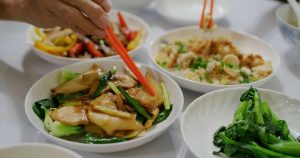//vol.15-4 Overview
Food for Thought
Why It Matters
by Mia Yao
As a carrier of culture that connects us through different communities, what does food tell us about the future?
As a migrant who came to Hong Kong five years ago, the daily question, “Where are you from?” was one I struggled to answer. This was because my hometown was not somewhere immediately identifiable, leading to further details, oft-times leading the questioner to being thoroughly confused.
I have now changed my response: “I come from a place known for Shanxi black vinegar and sliced noodles.” Recognition!
I then realised that my identity and identification was rooted in food rather than geography. It made me think about how we regularly take food for granted and see it as a daily necessity, rather than the carrier of culture that connects people.
Identification
In an interesting thesis, Thomas Talhelm put forward what is known as the “rice theory,” where he examined how rice and wheat have shaped culture and identity. According to his argument, the southern regions of China, with their labour-intensive rice farming culture, developed into more interdependent and tightly-knit communities in response to the demands of this staple crop. In contrast, the northern parts of China, where wheat and millet are more prevalent, more individualistic characteristics were apparent.
This symbiosis of food and identity, regional or national, is not unique to China. We know this from our own immediate connectors when thinking of food: spaghetti from Italy; fish and chips from Britain; sushi from Japan, or French baguettes, Korean kimchi, and Argentine Asado. Certain food items are not only tasted, but have become a geographical name card as well.
“Food is not rational. Food is culture, habit, craving, and identity,” American novelist Jonathan Safran Foer once put it. As a vehicle for expressing culture and identity, food choices can symbolise our religion, ethnicity, social class, and most importantly, give us a sense of belonging from an individual level.
Hong Kong food, known for its Cha Chaan Teng culture, is one of the most unique (or bizarre) mixes between east and west that most people will encounter. Many dishes from the west, like macaroni or cheese, are given a complete Hong Kong makeover, sometimes rendering its origins difficult to recognise. Much of this original “fusion” of tastes is a result of Hong Kong’s colonial past, influx of mainland immigrants from the 1950s, to the international city it has now become.
Connection
Beyond identity, food plays an important role in the formation and maintenance of our relationships. While this is not unique to Chinese culture, it was aptly depicted in Eat Drink Man Woman, a 1994 comedy-drama film directed by Ang Lee. We witness a father, elaborately preparing a banquet for his three grown daughters every Sunday. As the recurring symbol in the film, the weekly dinner is where audiences observe the dynamic shift in the relationships among the family members.
Beyond the familial context, the dining table is where people start conversations, get to know each other, and build connections regardless of age, gender, cultural backgrounds and political views. As a study from Oxford University exploring the role of food suggested, social eating may have evolved as a mechanism for facilitating social bonding. Eating with friends and family members provides a sense of community and support, making people happier and more satisfied with their lives. At a more personal level, we’ve all had that experience: He hates your favourite dish the most? No big deal; we are still friends.
Our Future
In spite of the issues of identity and relationship with notions of food, there is not necessarily a “happily ever after” story when looking into the future. In the first instance, one can experience, and not just in Hong Kong, how culinary traditions with distinct regional features are disappearing and being diluted amid globalisation. From an individual point of view, a tea house in which we shared a meal with our family 20 years ago is now nowhere to be found.
Similarly, as food evolves, along with dining habits, will that be unexpected when the younger generations in Hong Kong no longer remember what cart noodles taste like, or have tasted original recipes that were otherwise passed down from their great-great-grandma’s era?
Likewise with connections. Eating out, eating with friends and family, those habits are changing too. As a reminder of the past and where we come from, food carries our memories and moments with loved ones. The stories may differ, but the language of food is common to all. So how can we preserve these cherished memories while also embracing new flavours and culinary experiences?
Documentation may be part of the solution. Unlike paintings, architecture, music, and other art forms that can be readily recorded and preserved in tangible forms, our experiences of cooking and dining in specific moments are unique and cannot be duplicated. As individuals, it is crucial to start re-learning grandma’s special dishes, and retelling our stories about food to the future generation.
Yet at the same time we must also look forward and embrace the amazing innovations and fusions that the culture of food is presenting us. Creating new memories. Creating new dishes. In fact, creating a new and diverse food culture. What that calls for is meaningful dialogues between what has been and what might very well come, all over a steaming bowl of something to tantalise the taste buds. ■
References:
Thomas Talhelm, The Rice Theory of Culture
I. M. Dunbar, Breaking Bread: the Functions of Social Eating



